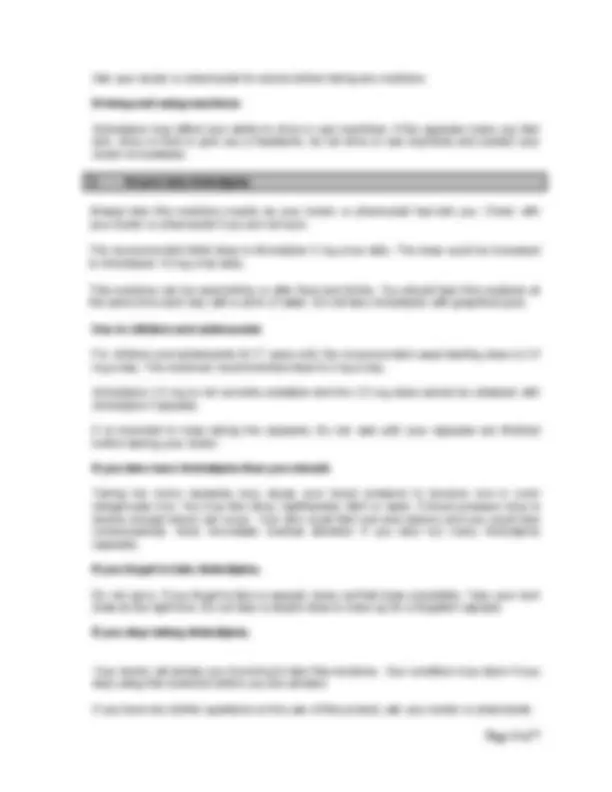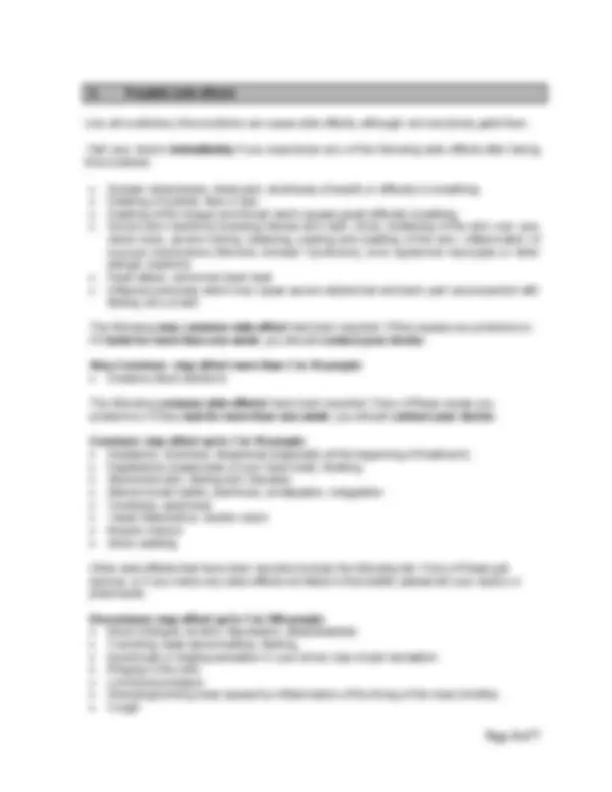





Study with the several resources on Docsity

Earn points by helping other students or get them with a premium plan


Prepare for your exams
Study with the several resources on Docsity

Earn points to download
Earn points by helping other students or get them with a premium plan
Community
Ask the community for help and clear up your study doubts
Discover the best universities in your country according to Docsity users
Free resources
Download our free guides on studying techniques, anxiety management strategies, and thesis advice from Docsity tutors
Information for users about Amlodipine, a medication used to treat high blood pressure and angina. It includes details on what the medicine is used for, warnings and precautions, how to take it, and possible side effects.
What you will learn
Typology: Exams
1 / 7

This page cannot be seen from the preview
Don't miss anything!




Amlodipine 5 mg & 10 mg Capsules Amlodipine Read all of this leaflet carefully before you start taking this medicine because it contains important information for you. Keep this leaflet. You may need to read it again If you have any further questions, ask your doctor or pharmacist This medicine has been prescribed for you only. Do not pass it on to others. It may harm them, even if their signs of illness are the same as yours. If you get any of the side effects, talk to your doctor, pharmacist or nurse. This includes any possible side effects not listed in this leaflet, See section 4. In this leaflet:
Severe increase in blood pressure (Hypertensive crisis) You are elderly and your dose needs to be increased Liver disease Children and adolescents Amlodipine has not been studied in children under the age of 6 years. Amlodipine should only be used for hypertension in children and adolescents from 6 years to 17 years of age (see section 3). For more information, talk to your doctor. Other medicines and Amlodipine Tell your doctor or pharmacist if you are taking or have recently taken any other medicines, including medicines obtained without a prescription. Amlodipine may affect or be affected by other medicines, such as: ketoconazole, itraconazole (anti-fungal medicines) ritonavir, indinavir, nelfinavir (so called protease inhibitors used to treat HIV) rifampicin, erythromycin, clarithromycin (antibiotics) hypericum perforatum (St. John’s Wort) verapamil, diltiazem (heart medicines) dantrolene (infusion for severe body temperature abnormalities) tacrolimus (medicine used to alter the way your immune system works.) simvastatin (cholesterol lowering medicine) cyclosporine (an immunosuppressant) Amlodipine may lower your blood pressure even more if you are already taking other medicines to treat your high blood pressure. Amlodipine with food and drink Grapefruit juice and grapefruit should not be consumed by people who are taking Amlodipine. This is because grapefruit and grapefruit juice can lead to an increase in the blood levels of the active ingredient amlodipine, which can cause an unpredictable increase in the blood pressure lowering effect of Amlodipine. Pregnancy and breast-feeding Pregnancy The safety of amlodipine in human pregnancy has not been established. If you think you might be pregnant, or are planning to get pregnant, you must tell your doctor before you take Amlodipine. Breast-feeding Amlodipine has been shown to pass into breast milk in small amount. If you are breast- feeding or about to start breast-feeding you must tell your doctor before taking Amlodipine
4. Possible side effects Like all medicines, this medicine can cause side effects, although not everybody gets them. Visit your doctor immediately if you experience any of the following side effects after taking this medicine. Sudden wheeziness, chest pain, shortness of breath or difficulty in breathing Swelling of eyelids, face or lips Swelling of the tongue and throat which causes great difficulty breathing Severe skin reactions including intense skin rash, hives, reddening of the skin over your whole body, severe itching, blistering, peeling and swelling of the skin, inflammation of mucous membranes (Stevens Johnson Syndrome), toxic epidermal necrolysis or other allergic reactions Heart attack, abnormal heart beat Inflamed pancreas which may cause severe abdominal and back pain accompanied with feeling very unwell The following very common side-effect has been reported. If this causes you problems or if it lasts for more than one week , you should contact your doctor. Very Common: may affect more than 1 in 10 people Oedema (fluid retention) The following common side effects have been reported. If any of these cause you problems or if they last for more than one week , you should contact your doctor. Common: may affect up to 1 in 10 people Headache, dizziness, sleepiness (especially at the beginning of treatment) Palpitations (awareness of your heart beat), flushing Abdominal pain, feeling sick (nausea) Altered bowel habits, diarrhoea, constipation, indigestion Tiredness, weakness Visual disturbance, double vision Muscle cramps Ankle swelling Other side-effects that have been reported include the following list. If any of these get serious, or if you notice any side-effects not listed in this leaflet, please tell your doctor or pharmacist. Uncommon: may affect up to 1 in 100 people Mood changes, anxiety, depression, sleeplessness Trembling, taste abnormalities, fainting Numbness or tingling sensation in your limbs; loss of pain sensation Ringing in the ears Low blood pressure Sneezing/running nose caused by inflammation of the lining of the nose (rhinitis) Cough
Dry mouth, vomiting (being sick) Hair loss, increased sweating, itchy skin, red patches on skin, skin discolouration Disorder in passing urine, increased need to urinate at night, increased number of times of passing urine Inability to obtain an erection; discomfort or enlargement of the breasts in men Pain, feeling unwell Joint or muscle pain, back pain Weight increase or decrease Rare: may affect up to 1 in 1 ,000 people Confusion Very rare: may affect up to 1 in 10,000 people Decreased numbers of white blood cells, decrease in blood platelets which may result in unusual bruising or easy bleeding Excess sugar in blood (hyperglycaemia) A disorder of the nerves which can cause muscles weakness, tingling or numbness Swelling of the gums Abdominal bloating (gastritis) Abnormal liver function, inflammation of the liver (hepatitis), yellowing of the skin (jaundice), liver enzyme increase which may have an effect on some medical tests Increased muscle tension Inflammation of blood vessels, often with skin rash Sensitivity to light Disorders combining rigidity, tremor, and/or movement disorders Reporting of side effects If you get any side effects, talk to your doctor or pharmacist or nurse. This includes any possible side effects not listed in this leaflet. You can also report side effects directly via HPRA Pharmacovigilance; Earlsfort; Terrace; IRL - Dublin 2; Tel: +353 1 6764971; Fax: +353 1 6762517; Website: www.hpra.ie; e-mail: medsafety@hpra.ie By reporting side effects you can help provide more information on the safety of this medicine
5. How to store Amlodipine Keep this medicine out of the sight and reach of children. Do not use this medicine after the expiry date which is stated on the pack after ‘EXP’. The expiry date refers to the last day of that month Capsules Do not store above 30°C
Chanelle Medical, Loughrea, Co Galway, Ireland. The manufacturer Chanelle Medical, Loughrea, Co Galway, Ireland. This leaflet was last revised in: May/201 8